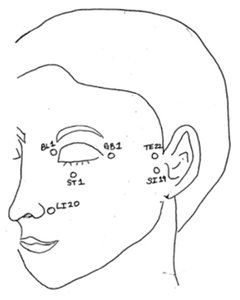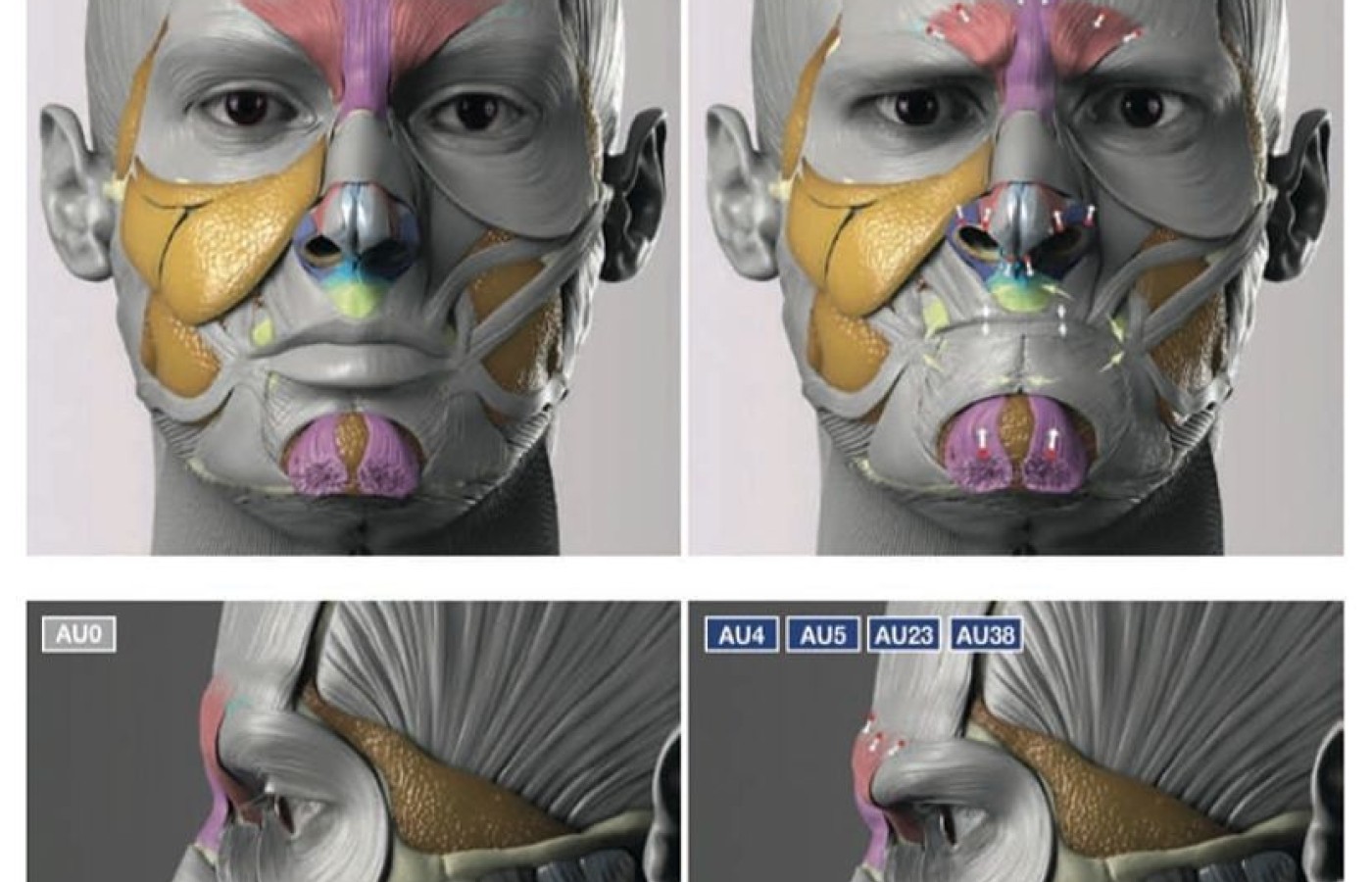One of the longest nerves in the body is known as the vagus nerve (VN). The VN is the 10th pair of cranial nerves that originates at the brain stem in the medulla oblongata. This nerve is part of the parasympathetic nervous system, which is a part of the ANS. Research suggests ear acupuncture can activate the VN.
The Anatomy of Expression (Pt. 2)
Editor's Note: Part 1 of this article appeared in the November digital issue.
Treating the Point
For each of the basic emotions, the diagnosis and treatment methods can be designed based on the different AUs involved.
One method of treatment is directly addressing the acupuncture or motor points responsible for specific muscle movements. By treating the point, you are treating the underlying nerves and muscles. Treating the acupuncture points in the muscles which are overused and have become tense or attenuated can help them to return to their normal functioning.
For example, if the frequent expression of anger is causing deep furrows in between the brows, you would treat the motor points and corresponding acupuncture points in the muscles used to make the expression.

The acupuncture and motor points used to treat the expression of anger would be:
- Corrugator supercilli: BL 2
- Procerus: Yin Tang
- Depressor supercillii: BL 2
- Levator palpebrae superioris: YuYao
- Nasalis: LI 20
- Orbicularis oris: LI 19 and halfway between ST 4 and Ren 24
- Mentalis: 1/2 cun lateral to Ren 24
- Dilator naris anterior and depressor septi nasi: DU 25 and 26
Treating the Channel
In addition to treating the acupoint in the muscle, one also must look at the both the correlation of the acupuncture point and its corresponding organ system. If a patient has deep frown lines, which correspond to expression of anger, treating heat or stagnation in the liver channel may create ease and relax the forehead. Conversely, treating the same points may relax the liver as well.
Energetic Blocks
In the Five-Element Acupuncture style popularized by J.R. Worsley, a block is defined as "a break in, or impediment to, the smooth flow of Qi."8 The Ling Shu ("Miraculous Pivot") teaches us, "Only when the stagnation is cleared away can the channels be vented and Yin and Yang be harmonized."9 If qi and blood cannot flow smoothly through the points, channels and muscles of the face, facial treatment will not be as effective and health will be compromised.
Blocks are diagnosed in various ways. Some show up on the pulses as a disparity in the strength of one pulse in relation to another; or in the strength of the left side pulses to the right (see below). Other blocks manifest primarily in a patient's physical or psycho-emotional state. In some instances, a patient's history can be indicative of a potential block; for example physical injury, emotional trauma and drug or alcohol abuse.
Blocks vary in severity and significance. Some are dire and require immediate attention, while others are less severe and merely resurface from time to time to cause troublesome symptoms. Energetic blocks such as aggressive energy or possession can become like a low-level infection or virus spreading toxins throughout the body.11 This list of blocks shows the order of treatment priority if they are present: possession (internal/external demons), aggressive energy, husband-wife, entry-exit (E/E). In this article I will only briefly discuss the entry exit block, as it directly relates directly to the face.
(For a more detailed explanation, please see my article, "The Importance of Clearing Blocks Prior to Facial Acupuncture Treatment."4 For detailed information on the diagnosis and treatment of the other blocks, please refer to The Clinical Practice of Chinese Medicine.11)
In Su Wen, chapter 8, the organs are portrayed in terms of their mental, emotional and spiritual functions. When emotions are prolonged, intense or unexpressed, they inhibit the normal flow of qi.
As mentioned, one of the most common causes of disease is the obstruction of the flow of qi caused by unexpressed emotions. Any energetic blocks which may be occurring inhibit the proper functioning of the muscle and smooth flow of qi throughout the channel. Repetitive or repressed expression can not only affect a person's appearance, but also can affect the associated organ system; in the following case, the fire and wood officials.
Treating the Block
As way of example, if during diagnosis a practitioner assessed an entry exit block on the pulse that pointed to a block between TH and GB (TH pulse larger than GB), the practitioner should look at both the local indications such as temporal headaches, or ringing in the ears and the spirit of the point (see below); and then assess what the underlying root cause of the condition is.
To treat this block, the practitioner would tonify* the exit point of the lower-numbered meridian (stronger pulse) (TE); and then tonify* the entry point of the next meridian(GB). This is done bilaterally. Remove, seal. (*Tonify = insert needle, turn 180 degrees clockwise.)
Treating the Spirit
According to the Su Wen, "in order to make all acupuncture thorough and effective one must first cure the spirit." The radiance of the skin and eyes is intrinsically connected to the spirit. Healing our patients at a deep level means learning about a patient's emotional spiritual well-being.
Using acupuncture points for their spiritual influence can encourage healing on a much deeper level than merely treating their physical attributes. The examples below are from my live and recorded classes, "The Anatomy of Expression"12 and "Facial Acupuncture Certification."13
Examples of points I have found particularly useful for their spiritual attributes are:
- ST 4, Ren 24 for treating bitterness, resentment resulting from overnurturing; typically seen in women who have to care for others against their wishes.
- ST 5 helps ease tightness in jaw due to holding back speaking what they are thinking, ingratiating behavior.
- GB 41 (Foot Above Tears): Allows for emotional release of frustration/anger. Grounds the patient. Spreads stagnant qi in liver and GB channel
- TE 17 (Wind Screen): Empowers us to be less susceptible to other people's opinions about us.11 Activates the channel. Alleviates wind, clears heat. Local point for lifting the face.
The order of treatment would be to first clear blocks and then treat any local face points and/or spirit points. Facial cupping and gua sha can also be an effective tool in releasing the tense muscles and improving blood and qi flow to under or overused muscles. Other methods of treatment include:
- Moving stagnant emotional state with xi cleft points
- Treating Windows of the Sky points
- Utilizing element points; for example, using a wood point on a meridian to treat anger
- Utilizing the Sheng or K'o cycles along with local face points to treat the resultant expression of the emotion. Example: Heat and inflammation arising in SI channel, causing teeth grinding ex. SI 3 with SI 19 sedate wood in fire or rage in face and face is hot sedate GB 41 and TE 3 wood in fire.
Clinical Pearls
The face can be a useful diagnostic tool for diagnosis and treatment planning. Our entire history lives in our face and it etched in our facial expressions. Relaxing and tonifying muscles, treating the spirit and clearing energetic blocks can bring forth universal emotional, spiritual and energetic shifts in our patients.
References (Both Parts)
- Lansley H. "The Seven Universal Facial Expressions." Click here to read.
- Du S, et al. Compound facial expressions of emotion. Proc Natl Acad Sci (U.S.), April 15, 2014;111(15):E1454-E1462.
- "Computer Maps 21 Distinct Emotional Expressions — Even ‘Happily Disgusted.'" Ohio State University News, March 31, 2014. Click here to read.
- Gellis M. The importance of clearing blocks prior to facial acupuncture treatment. J Chinese Med, November 2018;116.
- Klasen M, et al. Neural processing of emotion in multimodal settings. Front Hum Neurosci, 2014 Oct 21;8:822.
- Hennenlotter A, et al. The link between facial feedback and neural activity within central circuitries of emotion - new insights from botulinum toxin induced denervation of frown muscles, Cereb Cortex, 2009;19(3):537-42.
- Zarins U. (2017) Anatomy of Facial Expressions. New York: Anatomy Next, Inc., 2017.
- Smith SM. The Five Element Acupuncture Handbook. S.M. Smith: Columbia: S.M. Smith, 1998: p.147.
- Veith I. The Yellow Emperor's Classic of Internal Medicine. Oakland: University of California Press, 1972: p. 260.
- Ekman P, Freisen WV. Facial signs of emotional experience. J Person Social Psych, 1980;39(6):1125-34.
- Jarrett LS. The Clinical Practice of Chinese Medicine. Richmond: Spirit Path Press, 2003.
- Anatomy of Expression, Part 1 (webinar class). Click here to view.
- Modules 1-5 Facial Acupuncture CEU Certification Package. Click here to view.
- Gellis M. The unique aspects of diagnosing and treating the face in Chinese medicine. J Chinese Med, February 2021;125.



